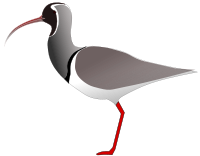Ibisbill
Conservation status Least concern |

|
|
Scientific classification |
| Kingdom: |
Animalia
|
| Phylum: |
Chordata
|
| Class: |
Aves
|
| Order: |
Charadriiformes
|
| Family: |
Ibidorhynchidae
Bonaparte, 1856 |
| Genus: |
Ibidorhyncha
|
| Species: |
I. struthersii
|
|
|
Binomial name |
Ibidorhyncha struthersii
(Vigors, 1832) |

|
The Ibisbill (Ibidorhyncha struthersii) is
a
bird related to the
waders, but sufficiently distinctive to merit its own
family Ibidorhynchidae.
It lives on the shingle riverbanks of the high plateau of
central
Asia and the Himalayas.
This bird is quite unmistakable. The adult is grey with a
white belly, red legs and long down curved bill, and a black
face and black breast band. The young birds lack the black
on the face and breast, and the bill is duller. The legs are
bright red in the breeding adults and dull sepia in
juveniles. In spite of its spectacular appearance it is
inconspicuous in its stony environment.
They feed by probing under rocks or gravel on stream
beds.
[1]
The call is a ringing Klew-klew similar to that of
a Greenshank.
It lays four eggs in a scrape on the ground.
The taxonomy position of the family is still unclear. It
may be related to both the oystercatchers and the avocets.
For an alternative classification of the Charadriiformes.
References
- ^
Marchant, J., Prater, T. and P. Hayman (1986)
Shorebirds: an identification guide to the waders of the
world. Christopher Helm.
- BirdLife International (2004).
Ibidorhyncha struthersii. 2006
IUCN Red List of Threatened Species. IUCN 2006. Retrieved on 11 May 2006. Database entry
includes justification for why this species is of least
concern
External links




